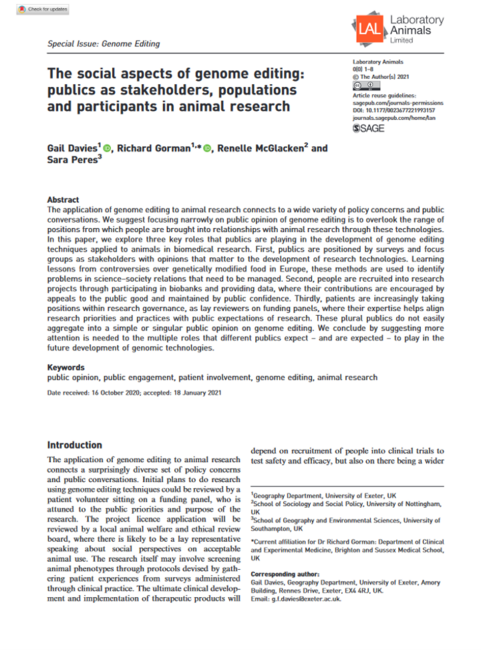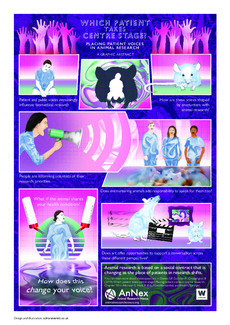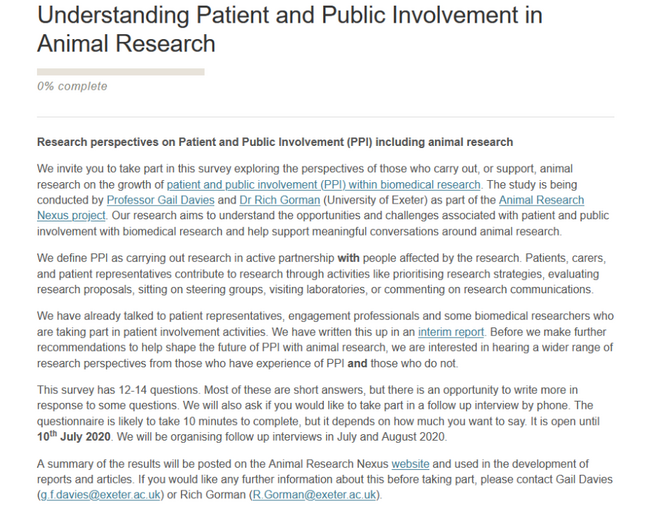Engagement & Involvement
Understanding patient and public involvement and engagement (PPIE) with the practices of animal research

Public and Patient Interfaces with Animal Research
Biomedical research is increasingly expected to be open and transparent, to translate laboratory findings into new drugs and treatments for humans and animals, and to engage the publics and patients who stand to benefit from this research. These demands have led to rapid growth in new forms of public and patient engagement and involvement across health research and clinical delivery. These innovations are beginning to open up new interfaces with the practices of animal research.
Animal facilities are opening their doors to host public tours and patient events. Patient groups are inviting animal researchers to provide updates at their meetings. Medical charities, who have close relationships with these scientists, are initiating discussions amongst their members about the use of animals. Public involvement practitioners are introducing conversations about animal research into activities that inform research priorities. Social media and short films are creating new spaces for public conversations between researchers and patients about the use of animals in their work.
At the University of Exeter, our work involved attending these events and talking to everyone involved to understand the range of opportunities, challenges, and questions these encounters create. We have used the idea of the animal research nexus to highlight the different expectations and experiences that organisers, researchers, and participants have of these events, and to work towards enhancing their value for everyone.
We published an Interim Report from our research to share our findings with research participants in early 2019. We have continued to work on analysis and developing these findings into presentations for different audiences and academic articles. In 2022, we published our report of practical next steps for Informing research involvement around animal research and devised a training workshop for researchers considering patient involvement, which was part of Beth Greenhough's work on Care-full stories.
If you have questions or suggestions about our research on public and patient interfaces with animal research, please feel free to contact Prof Gail Davies. This work would not have been possibly without the invaluable contributions of Dr Rich Gorman and Dr Gabrielle King, who have both now moved onto new roles where they are supporting the involvement of people affected by health conditions in the research that affects them.
Relevant, tagged site content:
Blog entry
Research conducted by members of the AnNex team has highlighted the growing number of initiatives designed to engage and involve people with health conditions with the research that affects them.
Care is complicated and hard.
A lot of guidance has been written about how to actively involve patients and the public in clinical research, and evidence is growing about the value of this.
Vector is an interactive experience, which uses elements of performance, game, and integrated technology to open up dialogue about the ethical dilemmas of using animals as part of medical research.
This is one of a series of Animal Research Nexus blogs drawing on our current and past work to explore the human-animal and science-society entanglements in the Covid-19 pandemic.
We are delighted to feature this guest blog on mice models in animal research from Nicole C. Nelson.
Numbers can be a contentious issue in animal research.
Our approach to research emphasises cross-project collaborations and transdisciplinary thinking. But what does this mean, in practical terms, for the work that we do and for our participants?
Earlier this year, the MRC Brain Network Dynamic Unit invited lay members of local branches of Parkinson’s UK to visit the unit
Animal research can be a controversial issue. It involves complex questions across science, health, animal welfare, and ethics and is the subject of ongoing social and scientific debate.
In July 2018 several members of the Animal Research Nexus team were invited to an exciting workshop at the University of Nottingham.
The concept of openness is increasingly being used to drive change and shape debates around animal research. However, it is a complicated and nuanced concept, which can be both uniting and dividing in practice.
Events
The Animal Research Nexus Programme is hosting a conference entitled 'Researching Animal Research' on 30th – 31st of March at the Wellcome Collection in London.
We are holding a workshop in April 2019 to bring together scientists and stakeholders to progress practices that will enable people to have more comfortable and productive conversations about animal research within the context of patient and publi
Publications
This report contributes to a growing body of advice around how to involve people affected by health conditions in laboratory or biomedical research. It draws on work completed as part of the Animal Research Nexus Programme (2017-2023) and brings together our findings with resources to help people who might be involved in conversations around the use of animals in laboratory research in the UK.
The increasingly global scope of biomedical research and testing using animals is generating disagreement over the best way to regulate laboratory animal science and care. Despite many common aims, the practices through which political and epistemic authority are allocated in the regulations around animal research varies internationally. This article proposes a framework for understanding and thinking across national differences in the regulation of animal research.
The application of genome editing to animal research connects to a wide variety of policy concerns and public conversations. In this paper, we explore three key roles that publics are playing in the development of genome editing techniques applied to animals in biomedical research: as publics, as populations, and as participants.
Rich Gorman’s secondment to the RSPCA explored the social relations shaping the use of horseshoe crab blood within pharmaceutical endotoxin testing. This involved 13 stakeholder interviews, and has resulted in a stakeholder report alongside a peer-reviewed journal publication. Rich has also presented the research at industry conferences and academic seminars. This is the report and infographic produced for his research.
A good culture of care, empowering individuals within organisations to care and reflecting wider social expectations about care, is now a well-documented aspiration in managing practices of laboratory animal research and establishing priorities for patient and public health. However, there is little attention to how different institutional cultures of care interact and what happens to the accountabilities of caring roles and the entanglements of caring practices when institutional cultures meet.
In this paper, in Tecnoscienza, we investigate translation in biomedicine by exploring how researchers supported by the British Pharmacological Society’s Integrative Pharmacology Fund (IPF) have responded to increasing translational aspirations within pre-clinical animal research.
Part of the Animal Research Nexus programme involves exploring the changing relationships between people affected by different health conditions and animal research. Our new chapter explores how ‘patient voices’ are represented around animal research. And we’ve made it into a graphic abstract...
Part of the Animal Research Nexus programme involves exploring the changing relationships between people affected by different health conditions and animal research. This chapter explores how ‘patient voices’ are represented around animal research.
The issues of openness, transparency and public engagement about animal research have taken focus in several different countries in recent years. This open access paper gives an account of a two-day-long, international expert forum on this topic.
This report discusses the different expectations people have of Patient and Public involvement and Engagement with animal research. We review the opportunities and challenges across perspectives. We also identify preliminary recommendations for enabling more meaningful involvement.
This report provides a record of the discussions at a workshop which brought together lay members from across the biomedical research sector to discuss the opportunities and challenges of shaping biomedical research.
This poster explains our research exploring how patients, publics, and practitioners might engage meaningfully around animal researc and identifying how people affected by health conditions might contribute to the research practices that potentially involve animal research.
Announcements
Are you interested in what conversations with patients or carers might offer your research? Or do you think patient involvement with biomedical research is not a current priority?
Project partners

The Medical Research Council’s Mary Lyon Centre (MLC) is located on the Harwell Campus, Oxfordshire.

The Medical Research Council Brain Network Dynamics Unit at the University of Oxford opened in April 2015.


























